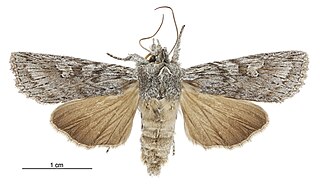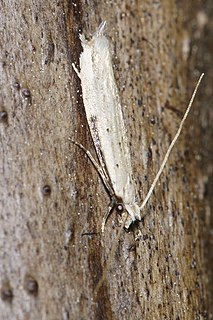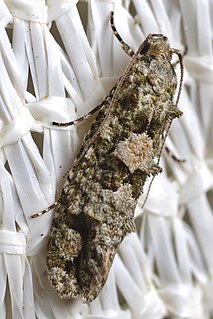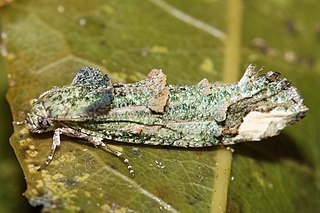
Habrophila is a genus of moths belonging to the family Tineidae. This genus was described by Edward Meyrick in 1889. It consists of only one species, Habrophila compseuta, which is endemic to New Zealand.

Izatha attactella is a moth of the family Oecophoridae. This species is endemic to New Zealand, where it is known from both the North and South Islands as far south as mid-Canterbury. Larvae of this species feed on the soft inner surface of the bark of dead trees and shrubs. Adults have been recorded from September to December.
Heterocrossa epomiana is a species moth in the family Carposinidae. It is endemic to New Zealand.

Heterocrossa eriphylla, also known as the lichen snoutlet moth, is a species of moth in the family Carposinidae. It is endemic to New Zealand. The larvae of this species feed on the healing wounds of New Zealand beech trees.

Heterocrossa exochana is a species of moth in the family Carposinidae. It is endemic to New Zealand.
Petasactis is a genus of moths belonging to the family Tineidae. It contains only one species, Petasactis technica, which is endemic to New Zealand. This species has not been collected since prior to 1888. It is classified as "Data Deficient" by the Department of Conservation.

Physetica phricias is a moth of the family Noctuidae. It is endemic to New Zealand. It is wide spread in the South Island and inhabits shrubland. The host of the larvae of this species is matagouri. The adult moths are on the wing from September to May and July, and are attracted both to light and sugar traps.They are a faster-flying species and remain active even during windy conditions. P. phricias can be confused with some forms of P. sequens. However P. phricias can be distinguished as it has a less marbled appearance to its forewing.

Endophthora omogramma is a species of moth in the family Tineidae. It was described by Edward Meyrick in 1888. This species is endemic to New Zealand.

Erechthias exospila is a species of moth in the family Tineidae. It was described by Edward Meyrick in 1901 using a specimen he collected in Whangarei in December. This species is endemic to New Zealand.

Erechthias hemiclistra is a species of moth in the family Tineidae. It was described by Edward Meyrick in 1911. This species is endemic to New Zealand. Entomologist George Hudson reared this moth from caterpillars and cocoons in the flower stems of Chionochloa conspicua at Makara. The adults emerged in November and February. The food of the larvae of this species is apparently dead woody fibre.

Erechthias macrozyga is a species of moth in the family Tineidae. It was described by Edward Meyrick in 1916. This species is endemic to New Zealand. The holotype specimen of this species was collected at Tisbury, Invercargill by Alfred Philpott.

Eschatotypa halosparta, also known as the salt and pepper fungus moth, is a species of moth in the family Tineidae. It was described by Edward Meyrick in 1919 from a specimen collected by George Vernon Hudson at Wainuiomata in December. This species is endemic to New Zealand. This species has also been collected near the Tui Mine in Te Aroha.

Eschatotypa melichrysa is a species of moth in the family Tineidae. It was described by Edward Meyrick in 1880. This species is endemic to New Zealand. Meyrick regarded them as common in Wellington and Dunedin, in December and January. He obtained specimens from beating forest growth.

Lysiphragma howesii is a species of moth in the family Tineidae. It was described by Ambrose Quail in 1901. This species is endemic to New Zealand.

Lysiphragma mixochlora is a species of moth in the family Tineidae. It was described by Edward Meyrick in 1888. This species is endemic to New Zealand.

Monopis ornithias is a species of moth in the family Tineidae. It was described by Edward Meyrick in 1888. This species is endemic to New Zealand.

Prothinodes grammocosma is a species of moth in the family Tineidae. It was described by Edward Meyrick in 1888. This species is endemic to New Zealand.

Prothinodes lutata is a species of moth in the family Tineidae. It was described by Edward Meyrick in 1914. This species is endemic to New Zealand.

Sagephora phortegella is a species of moth in the family Tineidae. It was described by Edward Meyrick in 1888. This species is endemic to New Zealand.

Tinea belonota is a species of moth in the family Tineidae. It is endemic to New Zealand. It is classified as not threatened by the Department of Conservation.


















